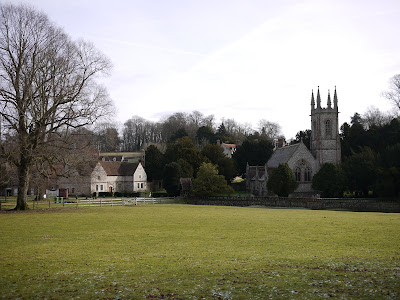The pretty village of Chawton is known principally for its Jane Austen connections. The walk begins opposite Jane Austen's house, but you immediately head away from it along the road towards St Nicholas church and Chawton House.
The house was owned by Jane's brother, Edward Knight, so there is no immediately escaping the Jane Austen connection. Maybe everybody else knows, but we immediately asked why Jane Austen's brother was not also called Austen? It turns out that he was adopted by Mr. Austen's patron, the rich but childless Thomas and Catherine Knight and took their surname. He later inherited the house from them.
Chawton House is now called Chawton House Library and is home to a charity with a unique collection of books focusing on women's writing in English from 1600 to 1830. Pevsner is fairly scathing about the building: "its details are so much restored that it is no longer a pleasure to look at" and "the best thing is the stables".

The stables on the left (now seemingly a dwelling), the church (by Sir Arthur Blomfield, 1871) and the house make a very picturesque grouping.

From here the route follows the A32 for a short way then heads across a field to enter a copse and then follows a track across country to Farringdon - one of Jane's favourite walks apparently.
Here you walk in a square around a delightful village, with interesting houses of many different periods. We just loved this late Victorian number, with its characteristic terracotta panels. It is Massey's Folly and was designed and built by the then vicar. It is now the village hall. Pevsner is a bit snooty about the terracotta panels - widely available from catalogues - but still very affecting and decorative. Well, I like them anyway.

Just around the corner, reasonably enough, you come to the church. You can plainly see from the outside the Norman nave and tower on the left and the Victorian chancel on the right. The porch is harder to guess - it dates from 1635.

In the church yard is this magnificent yew, with its vast girth and hollow middle.

You leave Farringdon and head west, crossing the A32 to reach the line of a disused railway, which you follow, crossing under a leafy bridge to the outskirts of Chawton.

Here we saw several members of the (we supposed) Chawton Metal Detection Society hard at work in the fields. Back across the A32, through some houses to return to the start.
From: Pocket Pub Walks: Hampshire by Nigel Vile (Countryside Books).
Map: Explorer 133 (Haslemere and Petersfield).
Conditions: cold, frozen ground, clear and sunny.
Distance: 4 miles.
Rating: Three and a half stars. Interesting and varied.




























